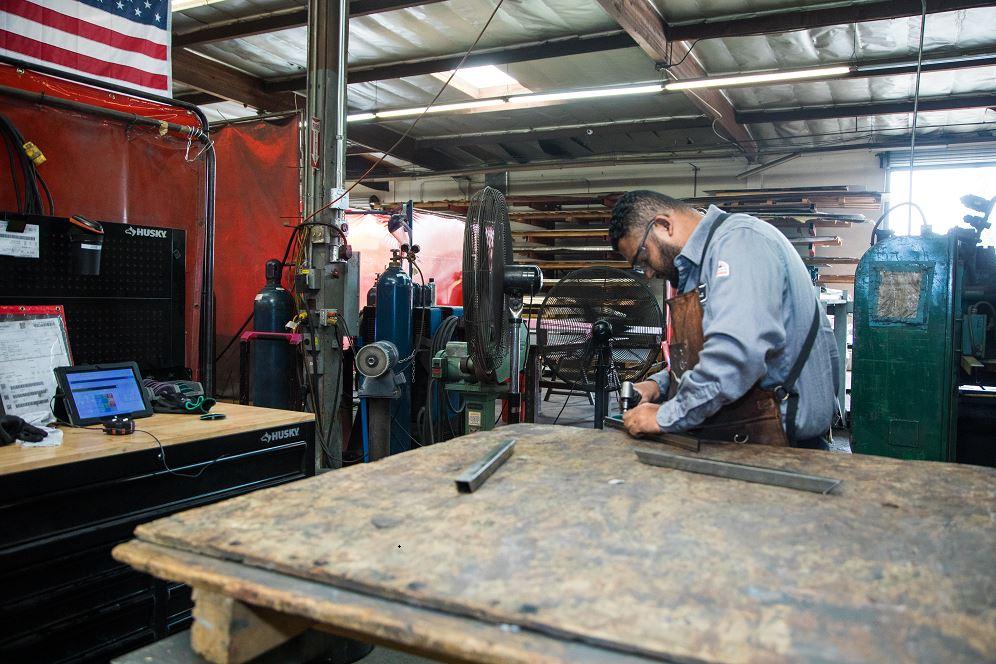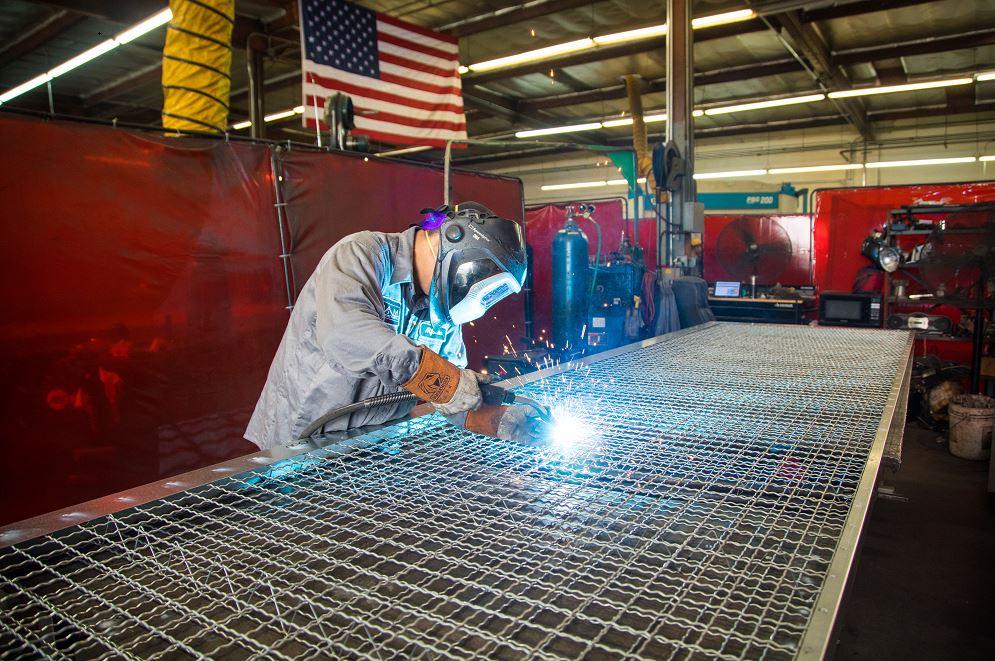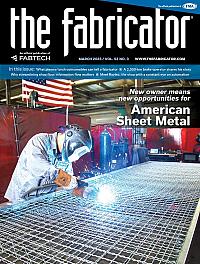Founder
- FMA
- The Fabricator
- FABTECH
- Canadian Metalworking
Categories
- Additive Manufacturing
- Aluminum Welding
- Arc Welding
- Assembly and Joining
- Automation and Robotics
- Bending and Forming
- Consumables
- Cutting and Weld Prep
- Electric Vehicles
- En Español
- Finishing
- Hydroforming
- Laser Cutting
- Laser Welding
- Machining
- Manufacturing Software
- Materials Handling
- Metals/Materials
- Oxyfuel Cutting
- Plasma Cutting
- Power Tools
- Punching and Other Holemaking
- Roll Forming
- Safety
- Sawing
- Shearing
- Shop Management
- Testing and Measuring
- Tube and Pipe Fabrication
- Tube and Pipe Production
- Waterjet Cutting
Industry Directory
Webcasts
Podcasts
FAB 40
Advertise
Subscribe
Account Login
Search
How a metal fabricator doubled revenue in two years
Good software tools sets foundation for growth in California sheet metal shop
- By Jules Brenner
- March 13, 2023
- Article
- Shop Management
Many companies in today’s economy are looking for ways to cut costs and increase efficiency, and mergers or acquisitions often can provide that. They are a powerful method for securing low interest rates, breaking into budding industries, and improving access to capital.
While the benefits of engaging in a merger or acquisition are well-understood, many legacy companies struggle to pass the baton without worrying about everything they’ve built being destroyed by the aggressive, quick-flip mentality of many private equity firms. Not only that, but oftentimes children and extended family are hesitant to inherit their family’s operations. They instead choose to follow their own passions and forge their own paths. All these factors create a risky, uncertain environment for family-run operations that don’t want to see their legacy crumble at the hands of short-sighted investment firms. Even so, they still need outside assistance to enable sustainable, long-term growth.
Although larger fabrication companies tend to get the most attention, small operations continue to dominate this business. In fact, many owners keep their businesses small to avoid the bureaucracy and personnel headaches that might come with a larger organization. They build reputations for great customer service. Word spreads, and demand from existing customers grows. Then comes a Catch-22: If the company doesn’t scale, how does it continue to satisfy its customers?
The industry finds itself at a kind of generational crossroads. Shop owners are retiring. If the owners’ children or those within the business aren’t interested in purchasing the business, what are their options? At worst, the purchasing company might acquire the shop assets, keep a few key people whose roles aren’t duplicated elsewhere, then lay off the rest. Alternatively, an owner could sell to outside investors looking for a quick return before selling the business off to someone else—again, a scenario that might not be ideal for existing employees.
Another emerging financial model could give both fab shop owners and employees a better option. Instead of selling the business outright at the five- to seven-year mark, the buyer can recapitalize the business, pay profit to equity shareholders, restructure debt, and repeat the process indefinitely. This model aims to shift the focus from short-term manipulating to building a sustainable business.
This model is providing the financial foundation for the recent acquisition of American Sheet Metal (ASM). The owner was looking to exit the business, but he also wanted to satisfy increasing customer demand and, especially, provide an environment that fostered employee growth.
Making this happen is a renewed focus on profits, streamlined employee communication, and smart use of software. Change happened rapidly, but because those changes made people’s working lives easier, employees embraced the change during a time of unprecedented growth. The right tools and technology have made this a reality.
Time to Pass the Torch
Based in Anaheim, Calif., ASM specializes in metal infrastructure parts, like those for highways, roads, transit stations, and bridges. ASM built a strong name in the Southern California infrastructure community by supplying custom parts, responding quickly to design changes, and offering same-day turnaround on specific projects. The company serves various end markets, including architectural metals, medical, aerospace, food service, and industrial equipment. Some notable projects include the LAX Automated People Mover project, various Metro train stations, and the 6th Street Viaduct Bridge.
There are exciting tail winds in the fabrication industry that are prepping ASM for long-term success. The forward momentum is further supported by the latest government investments in California’s infrastructure from local tax increases, the Build Back Better Act, and preparations for the 2028 Los Angeles Olympics.
The previous owner built the company on word of mouth and wanted to stay small “by design,” allowing the company to focus on each customer’s needs. ASM was growing 30% year over year at the time of sale. While the company generated healthy cash flow, it became too much of an operational headache and required reinvestment to keep up with increasing demand.
This is when Industrial Succession Group (ISG) stepped into the picture. I launched the investment group in 2020 intending to focus on small manufacturing companies with EBITDA (earnings before interest, taxes, depreciation, and amortization) of less than $5 million, and our first acquisition was ASM.
We play the long game. We’re not stripping and flipping. Instead, our acquisitions follow a cycle: invest and capitalize, pay profits to equity stakeholders, restructure debt, recapitalize, and so on. Any change we make needs to make sense over the long term.
The continual investment provided the foundation, but to truly scale, ASM needed more than funding. Again, ASM was amid a period rapid growth. To implement change during hectic times required working capital and a three-step improvement strategy that could be implemented from day one: First, clean; second, measure and manage; third, grow.
Step One: Clean
This involved both physical housekeeping as well as checking in on branding, customer experience, and modernization. Upon entering the ASM facility on the first day, we found piles of sheet remnants consuming precious floor space. The space hadn’t been cleaned in 10 years. There were no floor markings for shop flow or safety, and employees came to work dressed in old personal clothing. The team fixed this by hiring cleaners, striping lines on the facility floors, hiring a recurring uniform delivery service, and installing tall racks to make better use of floor space.
Soon after these improvements, representatives from ASM’s largest customer paid a visit. Because the company had no conference room, the representatives had to stand in the hallway. This did not bode well for the image of a leading fabrication company. After that, the ISG team updated the facility with an intensive office renovation that included a conference room, new office spaces, and a modern lobby. With new logos, signage, and a website, ISG also modernized ASM’s dated brand image.
Step 2: Measure
Like many small manufacturers, ASM relied heavily on pen and paper as well as dated and underutilized software. All this really couldn’t support the next phases of growth. The fabricator needed modern software tools to manage and organize data. Such systems are key for freeing more time to focus on business strategy and process improvement.
First, we digitized the paperwork by hiring a document scanning service and switching the enterprise resource planning (ERP) and accounting systems to cloud-based platforms. We used Fulcrum’s modern ERP software integrated with the online QuickBooks and allowed ASM to begin to track margins, reconcile jobs, and issue local shop control systems via iPads—which paid for themselves in just one week. They reduced wasted time from employees having to walk over to a single terminal to clock in and out at every operation.
The ERP’s dashboard also eliminated the need to have paper drawings and job travelers on-site. Overall, these improvements to ASM’s digital infrastructure helped bring its bookkeeping and production management software into more competitive territory. It helped improve employee efficiency, maximized cost efficiency, and improved their entire brand image. After all, in the age of smartphones and tablets, no one should be sharing a computer terminal.
Other improvements involved office procedures. Existing customers knew estimators’ direct numbers and email, but what about prospective customers and new suppliers or vendors? Also, what if someone arrived at the plant lobby? The business was too small to employ a full-time receptionist. Visitors weren’t walking in and out all day.
Many small businesses pride themselves in having that human touch. That is, when someone calls the main number, they want a human to answer; and when someone visits, they want someone there to greet them.
Hiring a receptionist costs money, though, which is why many shops resort to passing calls on to office workers, who then are forced to stop what they’re doing and answer the phone. Having an accountant or other office worker pull double duty at the front desk introduces a host of inefficiencies. Their jobs require concentration, and the more they’re disrupted unexpectedly, the harder their jobs become.
Here again, we turned to software. When someone enters the lobby, they use an iPad to register on an app called Greetly, where they enter their information and the purpose of their visit. The iPad takes their picture and sends information to the requested personnel, then tells the visitor that help is on the way. Complementing this is OnSIP, a VoIP phone system that gives callers a menu to direct their calls.
New software enhanced ASM’s data collection greatly, which in turn allowed the ISG team to set KPIs for all shop processes and margins. The team determined how to squeeze out more profit not by just focusing on jobs with the highest revenue but also by winning jobs that had higher overall profit margins. This helped improve the cash conversion cycle by almost two weeks and enabled more options for the reinvestment of profits.
ASM’s most profitable work involved expedites—customers that need something in a hurry. Yes, the work is difficult (hence its higher price), but ASM had the structure in place to master quick response. That said, if the company were to take on more expedited work, it needed more people.
As any sheet metal fabricator knows, good people are difficult to find. That said, this doesn’t mean the hiring process itself can’t be streamlined. Again, software helped. ASM now uses JazzHR, a platform that sends job notices to more than a dozen online job posting platforms.
It’s about analyzing what adds value and what doesn’t. Previously, the HR manager simply posted an ad to a single website. Other sites, it was thought, just weren’t worth the trouble. Using JazzHR, though, the hiring manager simply clicks through a few screens, then posts everywhere to cast a wide net. Ultimately, this helped the company improve hiring prospects and highlight top talent quickly.
Step 3: Manage and Grow
To grow and better manage cash, we needed revenue to be more predictable. Recurring revenue is hard to find in job shops. Nevertheless, the ISG team knew that by implementing a sales system and winning backlog, they could have more predictable revenue that would support long-term decision-making.
To this end, ISG implemented modern sales tracking software and email campaigning tools to track sales growth, customer acquisition rates, and customer retention. We knew that if we were going to be able to think bigger and achieve scalable growth, we needed to focus on these data points.
The first steps involved implementing a customer relationship management (CRM) platform called Pipedrive, which helped sales tracking, and Mailshake, which helped our email campaigning. Using these two tools, ASM could now track sales, understand its win rates, and forecast the percentage of backlog that was likely to convert to sales orders.
Next, we focused on increasing the company’s head count and pursuing low-hanging-fruit revenue streams. Before the acquisition, ASM would only pursue work from a few local government agencies. To open our focus to all the West Coast government agencies, ISG hired a shipping and receiving lead, developed relationships with shipping companies, and began to ask estimators to bid on work from all over the country.

First-shift employees at American Sheet Metal. In the back row, ISG’s Founder/President Jules Brenner is on the far left; ISG Associate Kenneth Pettibone is on the far right.
A few years prior to ISG’s ownership, ASM used to fabricate and install architectural sheet metal panels. The prior ownership stopped once they hit their sales goals on the infrastructure supply side of the business. To grow, the ISG team revived this division by hiring an architectural estimator and project manager as well as an installer who used to own his own company. This division has begun to show signs of doubling ASM’s total sales while providing more predictable revenue with large jobs that can run for months.
ASM also added a night shift and hired a part-time crew to help offset the increasing demand placed on the full-time crew. This doubled the head count in a short period of time and has allowed ASM to quote even faster turnarounds.
An Industry in Transition
These efforts have already contributed to increases in revenue and backlog, and ASM experienced 100% growth between 2021 and 2022. Moreover, we implemented most of these changes extremely quickly—many of them within days. I’ll be honest, the sudden change shocked the staff a little. But since the new tools made their jobs easier and more enjoyable, they embraced them.
This included those new uniforms, a small change that made a huge difference. Yes, shop floors aren’t as dirty as they used to be, but welding is still welding, and grinding is still grinding. People wearing uniforms made the atmosphere professional and allowed employees to keep work at work—no need to ruin personal clothing.
Hiring a scanning company, which could scan everything from the largest architectural drawings to the most basic napkin sketches, digitized the company’s job history. That investment will pay dividends for years. Giving everyone iPads made the paper shuffle a thing of the past.
All this set the foundation for where ASM is now, a company with predictable revenue (large architectural metal contracts) combined with the ability to fabricate parts quickly to customers who needed them yesterday (expedited orders).
Several years ago, ASM resembled many small sheet metal operations across the country. They might have new fiber lasers and press brakes, but they still rely on old ERP platforms and other software where one wrong keystroke can lead to hours of headache. They also rely on pen and paper as well as aging (and often bulging) filing cabinets to organize jobs and process orders. All that printing wastes more than just ink and paper. It wastes time. Even worse, it can frustrate talented employees just trying to get a job done.
Software investments, from hiring to cloud-based ERP and CRMs to virtual receptionists, helped ASM streamline the flow of information. Without them, the company’s dramatic growth just wouldn’t have been possible.

The fiber laser operator prepares the next job. Like many small shops, ASM invested in productive equipment, like fiber lasers and press brakes with user-friendly controls, yet still relied on paper-based workflow. Today, everyone can access everything associated with a job, including prints and even architectural drawings, on their iPads.
About the Author

subscribe now

The Fabricator is North America's leading magazine for the metal forming and fabricating industry. The magazine delivers the news, technical articles, and case histories that enable fabricators to do their jobs more efficiently. The Fabricator has served the industry since 1970.
start your free subscription- Stay connected from anywhere

Easily access valuable industry resources now with full access to the digital edition of The Fabricator.

Easily access valuable industry resources now with full access to the digital edition of The Welder.

Easily access valuable industry resources now with full access to the digital edition of The Tube and Pipe Journal.
- Podcasting
- Podcast:
- The Fabricator Podcast
- Published:
- 04/16/2024
- Running Time:
- 63:29
In this episode of The Fabricator Podcast, Caleb Chamberlain, co-founder and CEO of OSH Cut, discusses his company’s...
- Trending Articles
AI, machine learning, and the future of metal fabrication

Employee ownership: The best way to ensure engagement

Dynamic Metal blossoms with each passing year

Steel industry reacts to Nucor’s new weekly published HRC price

Metal fabrication management: A guide for new supervisors

- Industry Events
16th Annual Safety Conference
- April 30 - May 1, 2024
- Elgin,
Pipe and Tube Conference
- May 21 - 22, 2024
- Omaha, NE
World-Class Roll Forming Workshop
- June 5 - 6, 2024
- Louisville, KY
Advanced Laser Application Workshop
- June 25 - 27, 2024
- Novi, MI





























